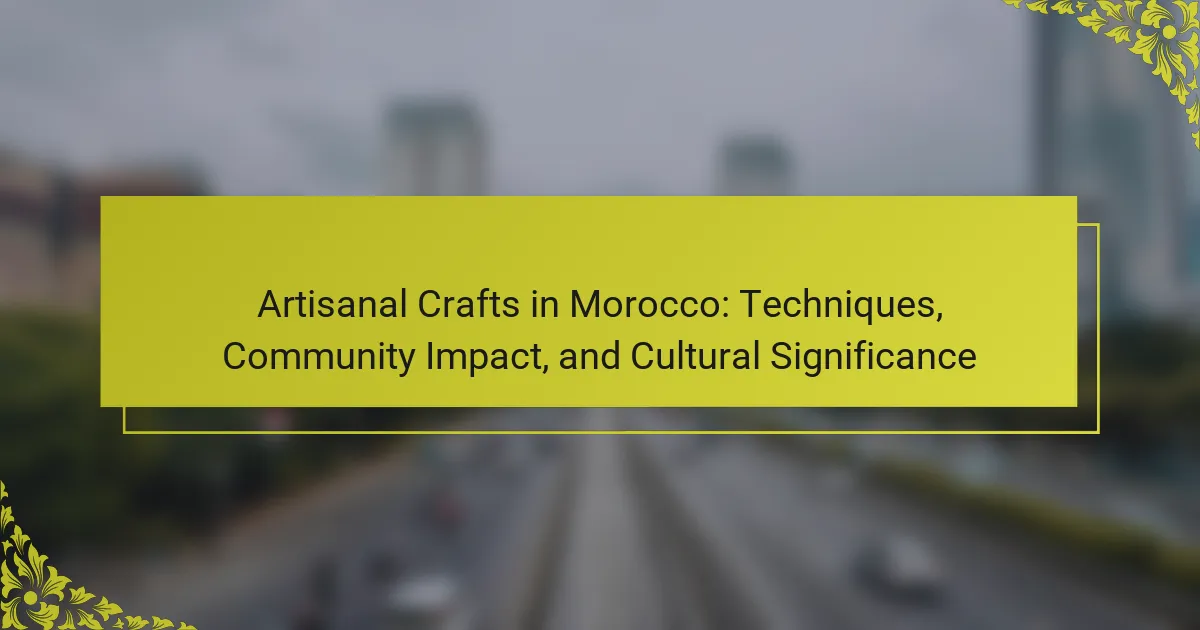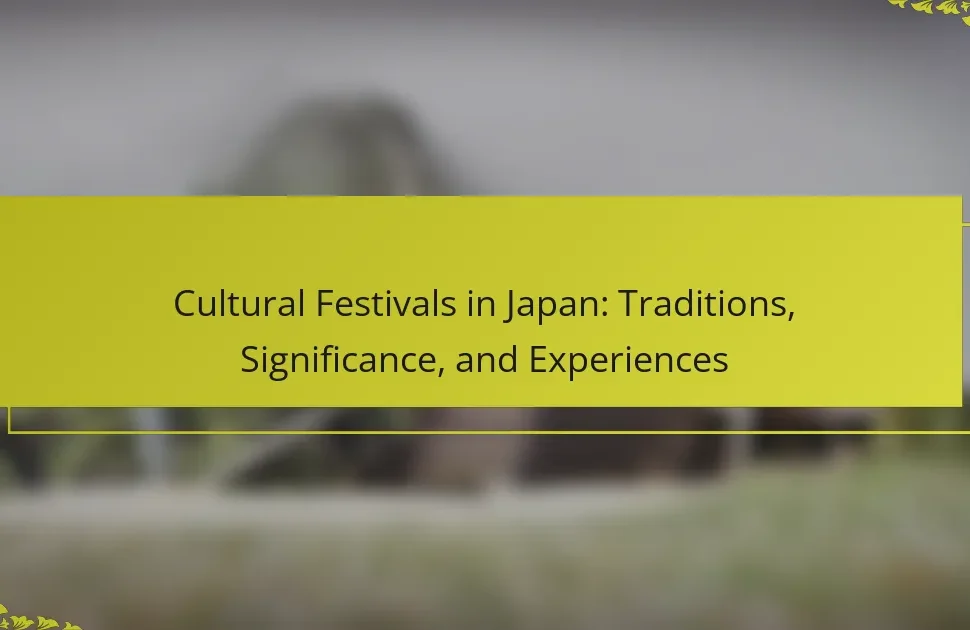Artisanal crafts in Morocco offer a glimpse into the country’s rich cultural heritage and community identity. This article explores traditional techniques like weaving, pottery, leatherwork, and metalworking. It examines the impact of these crafts on local economies and community cohesion. Additionally, it highlights the cultural significance of Moroccan craftsmanship in preserving traditions amidst modern challenges.
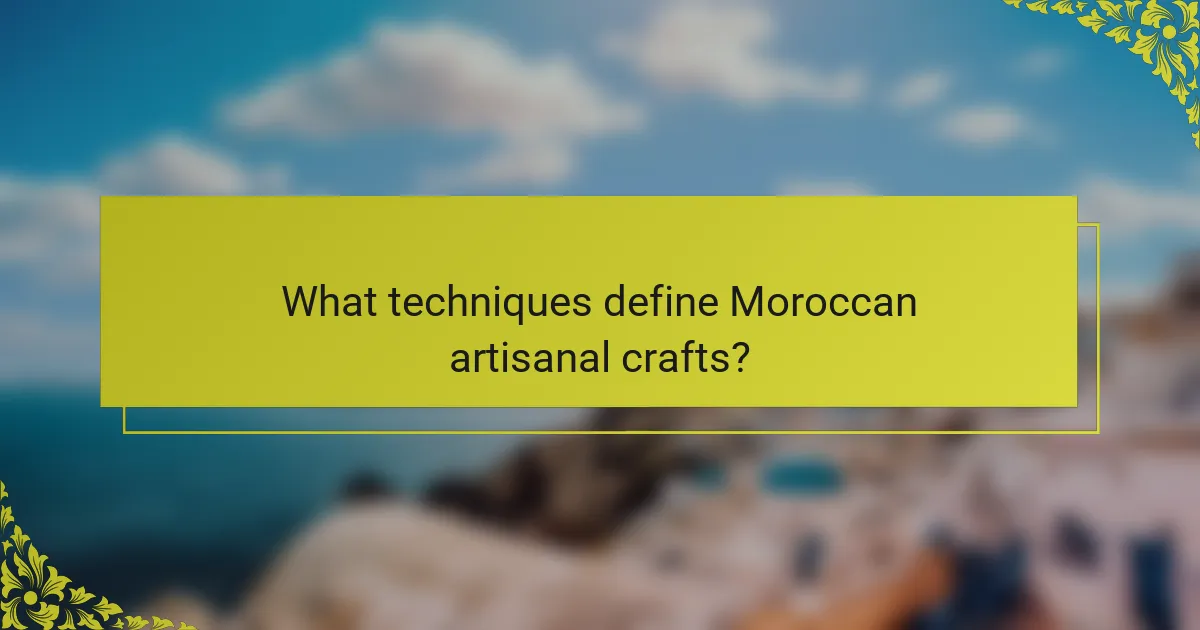
What techniques define Moroccan artisanal crafts?
Moroccan artisanal crafts are defined by techniques such as weaving, pottery, leatherwork, and metalworking. These methods showcase traditional skills passed down through generations, reflecting cultural heritage and community identity. Weaving techniques include intricate patterns in textiles, while pottery often features unique glazes and shapes. Leatherwork involves traditional tanning methods, creating durable goods. Metalworking showcases craftsmanship in decorative items and tools, often using copper and brass. Each technique contributes to the rich tapestry of Moroccan culture, emphasizing the importance of artisanal practices in local economies and community cohesion.
How do traditional methods influence craft quality?
Traditional methods significantly enhance craft quality by emphasizing skill, authenticity, and cultural heritage. Artisans in Morocco utilize techniques passed down through generations, ensuring meticulous attention to detail. This dedication results in unique, high-quality products that reflect the community’s identity. The rare attribute of using local materials further elevates the craftsmanship, making each piece not just a product but a representation of Moroccan culture.
Which materials are commonly used in Moroccan crafts?
Common materials used in Moroccan crafts include leather, wood, ceramics, metal, and textiles. These materials reflect the rich cultural heritage and artisanal techniques of Morocco.
Leather is often sourced from goats and camels, used in items like bags and slippers. Wood, especially cedar, is carved into intricate designs for furniture and decorative pieces. Ceramics feature vibrant colors and patterns, primarily in dishware and tiles. Metalwork, particularly brass and silver, creates stunning jewelry and decorative objects. Textiles, such as wool and cotton, are woven into carpets and traditional clothing, showcasing unique patterns and craftsmanship.
How are regional variations reflected in craft techniques?
Regional variations in craft techniques reflect local resources, cultural influences, and historical practices. In Morocco, artisans utilize distinct materials and methods based on their region. For example, Berber weavers in the Atlas Mountains employ traditional techniques using local wool, while coastal artisans craft intricate pottery from clay found near the ocean. These variations enhance the cultural significance of each craft, fostering community identity and preserving heritage. As a result, the diversity in Moroccan artisanal crafts showcases the unique attributes tied to regional practices.
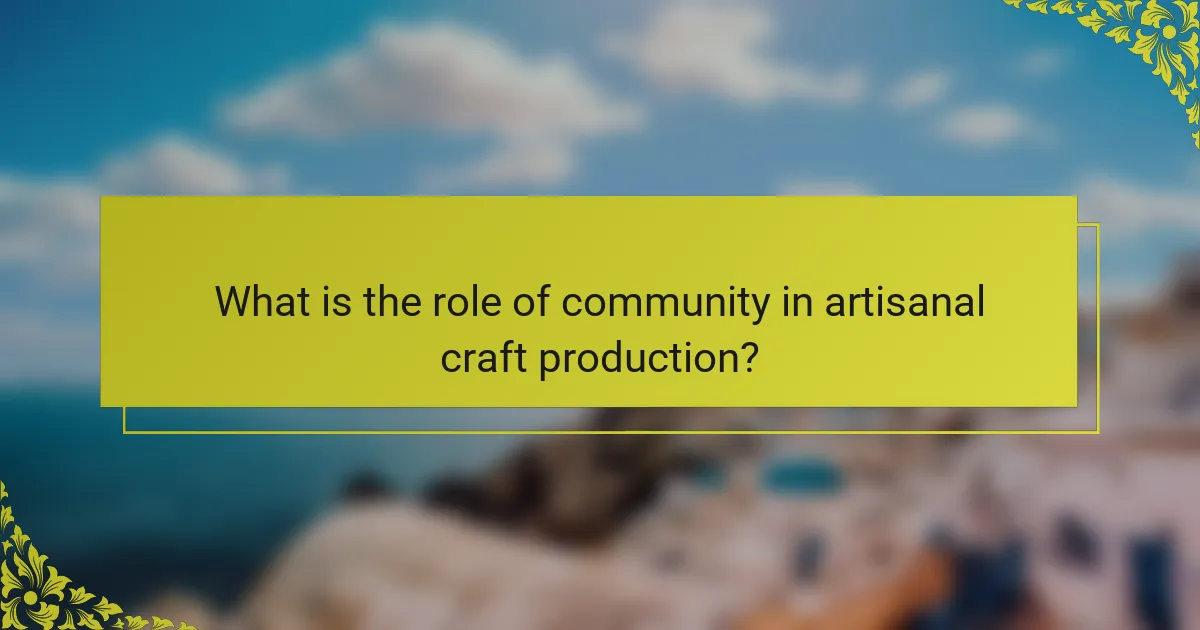
What is the role of community in artisanal craft production?
Community plays a crucial role in artisanal craft production by fostering collaboration and preserving cultural heritage. Local artisans often share techniques and resources, enhancing skill development and creativity. This collaborative environment strengthens social bonds and promotes economic sustainability. Additionally, community involvement ensures that traditional crafts are passed down through generations, maintaining cultural significance and identity. The unique attributes of Moroccan craftsmanship, such as intricate designs and local materials, reflect the community’s collective identity and values. As a result, artisanal crafts become not only products but also expressions of community stories and traditions.
How do artisans collaborate within local communities?
Artisans collaborate within local communities by sharing techniques, resources, and cultural practices. This collaboration fosters social cohesion and economic resilience. For example, artisans often form cooperatives, allowing them to pool resources and reach broader markets. These partnerships enhance the visibility of traditional crafts, ensuring their cultural significance is preserved while providing livelihoods. Community workshops also promote skill-sharing, enabling artisans to innovate and adapt techniques, enriching the local craft landscape.
What impact do crafts have on local economies?
Crafts significantly boost local economies by creating jobs, attracting tourism, and fostering community engagement. Artisanal crafts in Morocco, such as pottery and weaving, not only preserve cultural heritage but also provide sustainable income for artisans. The unique techniques used in these crafts enhance their market value, making them sought after both locally and internationally. As a result, the crafts sector contributes to economic resilience, empowering communities and promoting cultural exchange.
How do gender dynamics shape artisanal practices?
Gender dynamics significantly influence artisanal practices in Morocco, affecting roles, techniques, and community engagement. Women often focus on traditional crafts, preserving cultural heritage, while men may engage in more commercial aspects. This division shapes the community’s economic landscape and cultural identity. Women artisans contribute unique perspectives and skills, enhancing the diversity of artisanal output. Their involvement fosters community cohesion and promotes gender equality, showcasing the evolving role of women in Morocco’s artisanal sector.
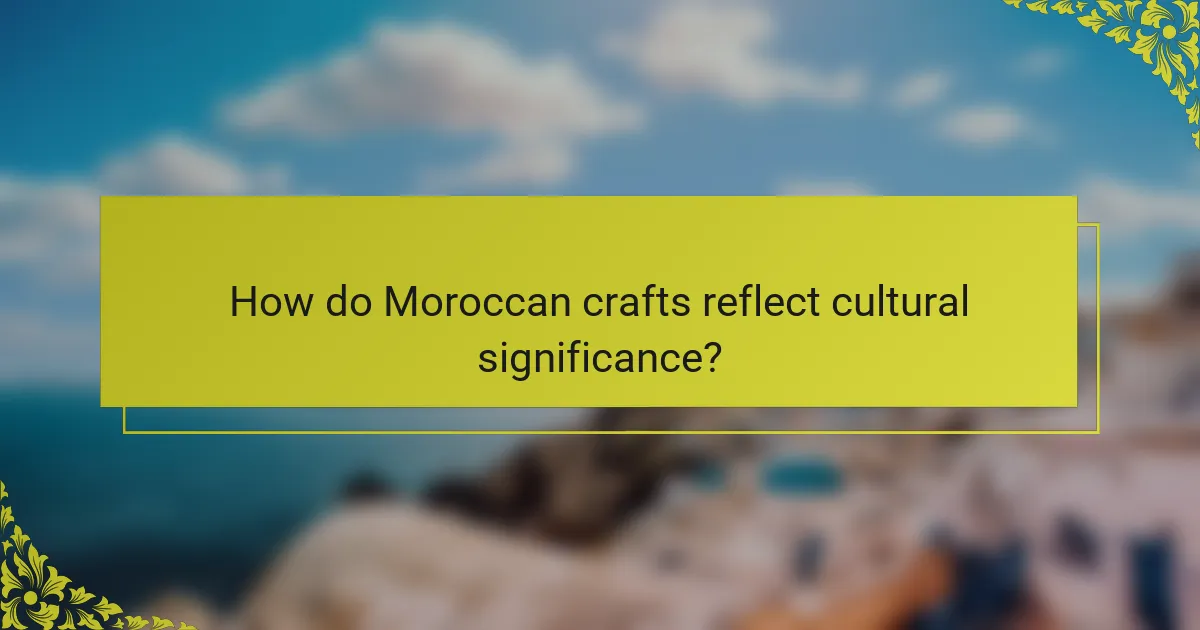
How do Moroccan crafts reflect cultural significance?
Moroccan crafts reflect cultural significance through their intricate designs and traditional techniques. These crafts embody the history, values, and identity of Moroccan communities. For example, pottery and weaving often incorporate symbols that tell stories of heritage. Additionally, artisans play a crucial role in preserving these traditions, fostering community bonds and economic sustainability. The unique attributes of Moroccan crafts, such as the use of local materials and traditional methods, contribute to their authenticity and cultural relevance.
Which symbols and motifs are prevalent in Moroccan craftsmanship?
Traditional Moroccan craftsmanship features symbols and motifs that reflect the country’s rich cultural heritage. Common elements include geometric patterns, floral designs, and calligraphy, each representing various cultural narratives and beliefs. Geometric patterns signify harmony and balance, while floral motifs often symbolize nature’s beauty. Calligraphy showcases the importance of language and spirituality in Moroccan culture. These symbols are prevalent in various crafts, such as pottery, textiles, and woodwork, enhancing their aesthetic and cultural significance.
How do crafts convey historical narratives?
Artisanal crafts in Morocco convey historical narratives through traditional techniques and cultural symbolism. Each craft reflects the region’s history, social structures, and community practices. Techniques like pottery, weaving, and metalwork are passed down through generations, preserving stories of artisans’ ancestors. These crafts often incorporate local materials and motifs, representing the identity and heritage of Moroccan communities. As a result, they serve as tangible links to the past, fostering cultural continuity and pride among artisans and their communities.
What role do festivals play in promoting traditional crafts?
Festivals play a crucial role in promoting traditional crafts by providing artisans a platform to showcase their skills. These events foster community engagement and cultural exchange, enhancing appreciation for artisanal techniques. For instance, Moroccan festivals often feature live demonstrations, allowing visitors to witness craftsmanship firsthand. This exposure boosts local economies and preserves cultural heritage, ensuring that traditional crafts remain vibrant and relevant. Additionally, festivals create opportunities for artisans to network, collaborate, and innovate, further enriching the craft community.
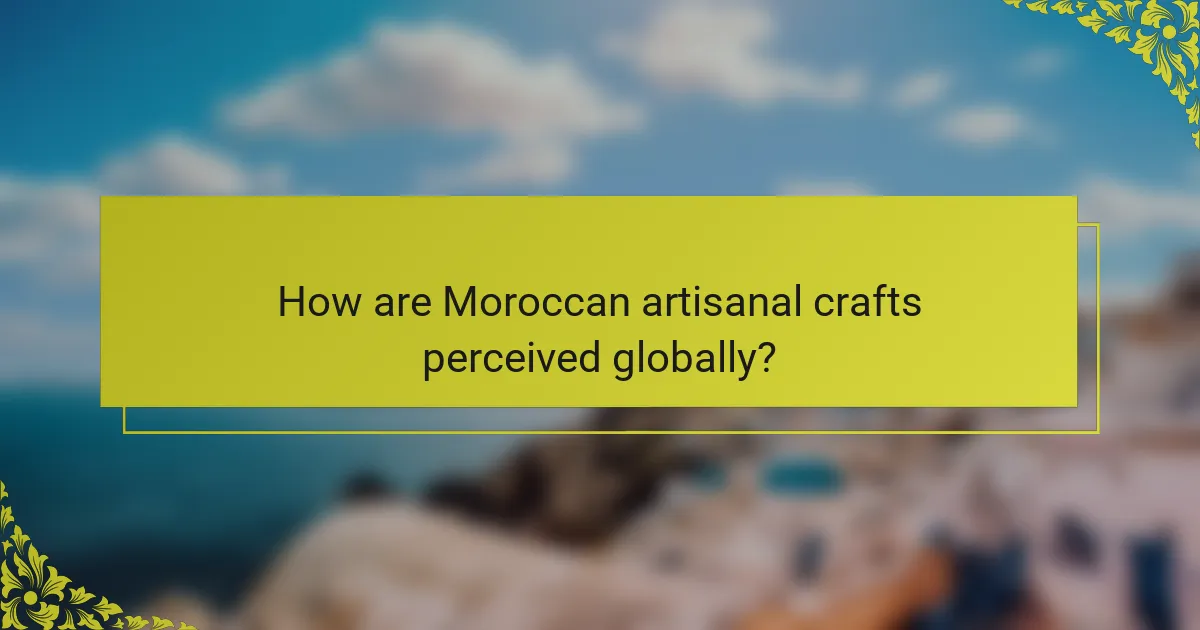
How are Moroccan artisanal crafts perceived globally?
Moroccan artisanal crafts are highly regarded globally for their unique techniques and cultural significance. These crafts reflect the rich heritage and traditional skills passed down through generations. The intricate designs and quality materials used in Moroccan crafts, such as pottery, textiles, and metalwork, attract international attention. As a result, these crafts not only support local economies but also promote cultural exchange and appreciation worldwide. The global perception of Moroccan artisanal crafts emphasizes their authenticity and the community’s commitment to preserving traditional practices.
What trends are shaping the international market for Moroccan crafts?
Artisanal crafts in Morocco are increasingly influenced by global trends such as sustainability, digital marketing, and cultural exchange. These trends enhance the visibility and economic viability of Moroccan artisans.
Sustainability is a key focus, with artisans adopting eco-friendly materials and techniques. This aligns with global consumer preferences for environmentally responsible products.
Digital marketing plays a crucial role in promoting Moroccan crafts internationally. Artisans leverage social media platforms to showcase their work, reaching broader audiences and increasing sales opportunities.
Cultural exchange fosters appreciation for Moroccan craftsmanship. Collaborations with international designers introduce innovative techniques, enriching the traditional craft landscape while preserving cultural heritage.
How do consumer preferences influence craft production?
Consumer preferences significantly shape craft production in Morocco by driving demand for specific techniques and materials. Artisans adapt their methods to align with market trends, prioritizing quality and authenticity. This responsiveness enhances community engagement, as artisans often collaborate with local suppliers to source traditional materials, fostering economic sustainability. Additionally, consumer interest in cultural significance influences the promotion of unique attributes, such as intricate designs and historical narratives tied to specific crafts. This dynamic interplay ensures that artisanal practices remain relevant and vibrant in the marketplace.
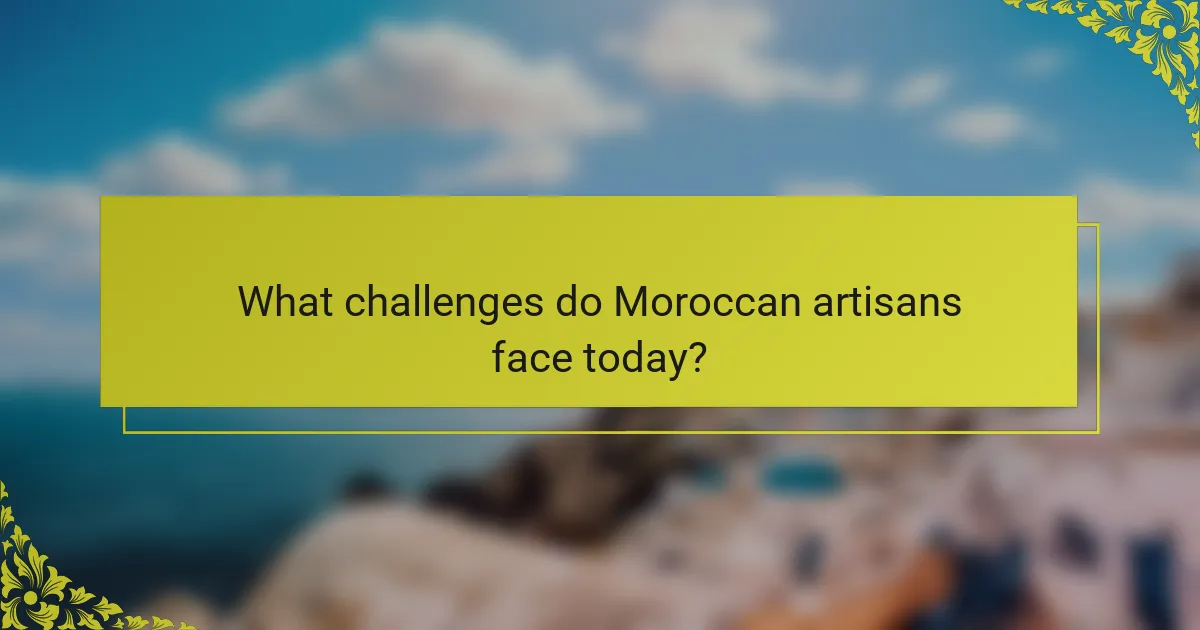
What challenges do Moroccan artisans face today?
Moroccan artisans face significant challenges today, including economic pressures, competition from mass-produced goods, and limited access to markets. These factors threaten the sustainability of traditional crafts. Additionally, the younger generation often seeks modern employment, leading to a decline in skilled artisans. Cultural preservation is at risk as globalization influences consumer preferences.
How does globalization affect traditional crafting techniques?
Globalization significantly influences traditional crafting techniques in Morocco by introducing new materials and market demands. Artisanal crafts, such as pottery and weaving, face challenges from mass production. This shift can lead to a decline in cultural significance and community practices. However, globalization also creates opportunities for artisans to reach broader markets, enhancing their economic viability. Balancing tradition with modern influences is essential for preserving Morocco’s rich crafting heritage.
What are the barriers to access for artisans in rural areas?
Artisans in rural areas face significant barriers to access, including limited market reach, inadequate infrastructure, and lack of financial resources. These challenges hinder their ability to sustain and grow their crafts. Additionally, insufficient training and support networks further impede their development. Access to technology and information is often restricted, limiting opportunities for innovation and collaboration.
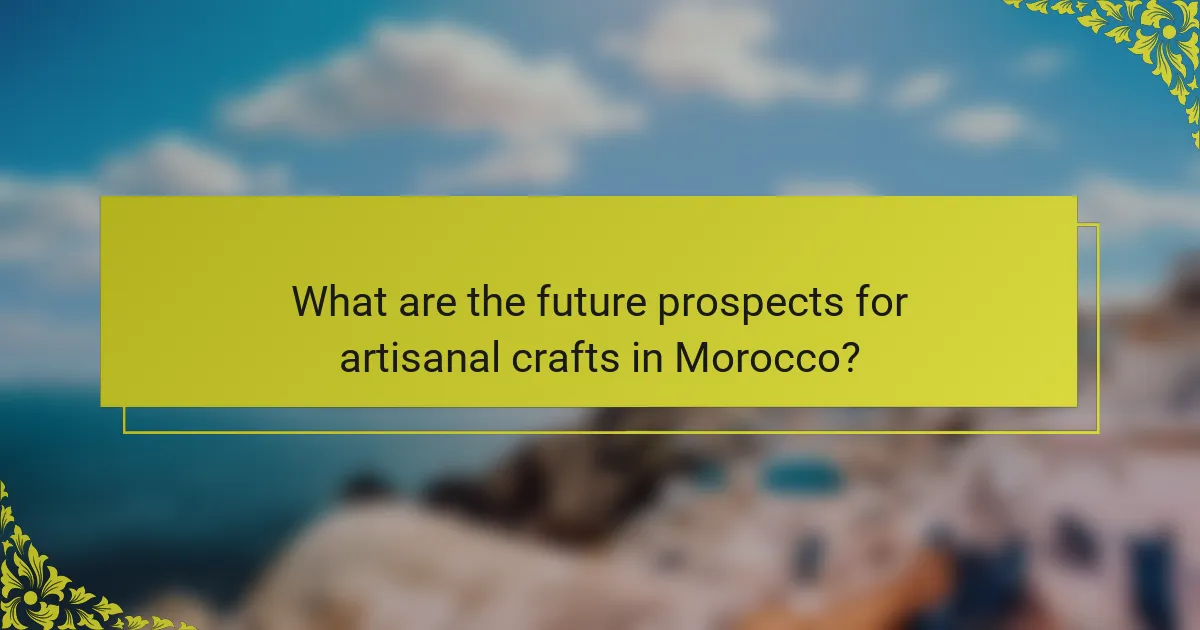
What are the future prospects for artisanal crafts in Morocco?
Artisanal crafts in Morocco have promising future prospects due to increasing global demand for authentic and sustainable products. The integration of modern techniques with traditional craftsmanship enhances creativity and marketability. Community engagement fosters skill development and economic growth, ensuring preservation of cultural heritage. Additionally, the rise of eco-tourism presents new opportunities for artisans to showcase their work.
How can sustainable practices be integrated into craft production?
Sustainable practices can be integrated into craft production through the use of eco-friendly materials and traditional techniques. Artisans in Morocco often utilize natural dyes and locally sourced resources, reducing environmental impact. Community workshops promote awareness of sustainable methods, fostering cultural preservation and economic resilience. Engaging local communities ensures that craft production aligns with environmental goals while enhancing cultural significance.
What innovations are emerging in the artisanal sector?
Innovations in the artisanal sector include the integration of technology and sustainable practices. Artisans in Morocco are adopting digital platforms to reach broader markets. They are also utilizing eco-friendly materials, enhancing both their craft and environmental impact. Additionally, community workshops are emerging, fostering collaboration and skill-sharing among artisans, which strengthens cultural ties.
What strategies can artisans adopt to enhance their market reach?
Artisans can enhance their market reach by leveraging digital platforms, collaborating with local businesses, and participating in cultural events. Utilizing social media allows artisans to showcase their crafts to a broader audience. Collaborations with local hotels or restaurants can create unique selling opportunities. Engaging in cultural festivals promotes visibility and appreciation for their work. These strategies not only increase sales but also strengthen community ties and cultural significance.
What best practices can ensure the preservation of traditional crafts?
To preserve traditional crafts in Morocco, fostering community engagement and education is essential. Collaboration among artisans, local governments, and NGOs can enhance skills and promote cultural heritage.
1. Promote workshops and training programs to pass down techniques.
2. Support local artisans through fair trade initiatives.
3. Encourage tourism that highlights artisanal crafts.
4. Document and archive traditional methods for future generations.
5. Utilize social media to raise awareness and appreciation.
6. Create networks for artisans to share resources and knowledge.
